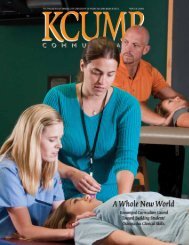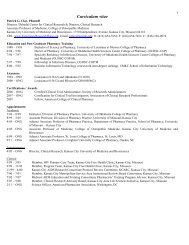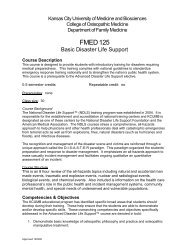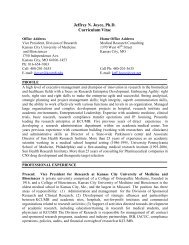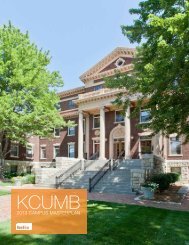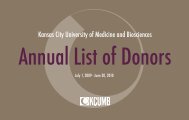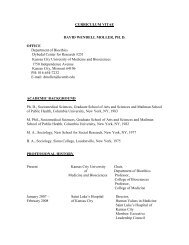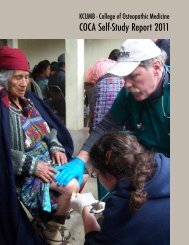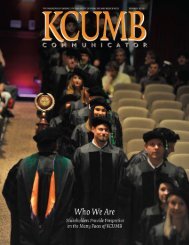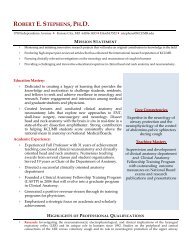KCUMBmagazine - Kansas City University of Medicine and ...
KCUMBmagazine - Kansas City University of Medicine and ...
KCUMBmagazine - Kansas City University of Medicine and ...
Create successful ePaper yourself
Turn your PDF publications into a flip-book with our unique Google optimized e-Paper software.
In the Eye<strong>of</strong> the BeholderThe Pleasures <strong>and</strong> Perils<strong>of</strong> Making People BeautifulBy Christopher RyanPhotography by Mark Harmel,Ken Krakow <strong>and</strong> Mark McDonaldWithin many physicians who provide surgical or non-surgical proceduresto enhance their patients’ appearance beats the heart <strong>of</strong> an artist.Whether these practitioners sculpt bodies through liposuction, alterthe shape <strong>of</strong> noses <strong>and</strong> ears, or erase unwanted tattoos, they are dedicated to helpingtheir patients look better <strong>and</strong>, therefore, feel better – at least about themselves.Unlike most artists, however, they believe they have succeeded most when noone can figure out what they have done. And, they must be doing something right.The number <strong>of</strong> surgical <strong>and</strong> non-surgical cosmetic procedures performed inthe United States exploded from about 1.7 million in 1997 to almost 9.2 million in2011, according to the American Society for Aesthetic Plastic Surgery. Women currentlyreceive about 91 percent <strong>of</strong> all cosmetic procedures. However, the number <strong>of</strong>men seeking cosmetic procedures increased 121 percent between 1997 <strong>and</strong> 2011.The amount <strong>of</strong> money spent on cosmetic procedures is more than a blip onthe economic screen. In 2011, the ASAPS reports, “Americans spent nearly $10billion on cosmetic procedures … Of that total, $6.2 billion was spent on surgicalprocedures; $1.7 billion was spent on injectable procedures; $1.6 billion was spenton skin rejuvenation procedures; <strong>and</strong> more than $360 million was spent on othernonsurgical procedures, including laser hair removal <strong>and</strong> laser <strong>of</strong> leg veins.”in 2011, non-surgical procedures accounted for 82 percent <strong>of</strong> the total procedures,but only 37 percent <strong>of</strong> patient expenditures. The other 63 percent wasspent on surgery, with liposuction, breast augmentation, abdominoplasty (tummytuck), blepharoplasty (eyelid lift) <strong>and</strong> breast lift making up the five most frequentlyrequested operations among women. For men, the top five were liposuction, rhinoplasty,blepharoplasty, breast reduction <strong>and</strong> facelift.Why Fight Nature?Physicians who perform cosmetic procedures recognize the pressure theirpatients face from a society obsessed with a certain definition <strong>of</strong> beauty.Julie Edween, D.O. (COM ’95), who is board-certified in facial plastic <strong>and</strong> cosmeticsurgery, has her <strong>of</strong>fice in the middle <strong>of</strong> Beverly Hills, Calif. A significantnumber <strong>of</strong> her patients would qualify as celebrities. She underst<strong>and</strong>s the pressureto fit a mold, but she has a more nuanced view <strong>of</strong> people’s motivations.“I believe people go for cosmetic surgery because there’s a big drive to look acontinued on page 12John Russell, D.O. (COM ’88) Julie Edween, D.O. (COM ’95) A. Daniel Tol<strong>and</strong>, D.O. (COM ’80)10 WINTER 2012WINTER 2012 11




